Behind the Explosive Popularity of TG Bots Intention Trading is Opening the Door to Web3 Interaction Intelligence
TG Bots Intention Trading is Fuelling Web3 Interaction IntelligenceSummary (TL;DR)
(1) Understanding Intent: Top-down Anoma vs. Bottom-up TG Bot
(2) Delving into Intent: AI is the New UI: Complex Commands vs. Simple Intent
(3) Navigating Intent: Concept Evolution, Interaction Paradigms, Current State, and Trends
(4) Guiding Intent: Challenges and Prospects of Web3 Interactive Intelligence
- Exploring the Significance of Web3’s Public Goods and Ownership for the Future of the Internet
- FTX Latest Debt and Asset Summary How much money is owed and how much debt can be repaid?
- FTX’s approval for liquidating $3.4 billion worth of tokens this week, what impact will it have on the market?
In June, LianGuairadigm published an article on its official website titled “Intent-Based Architectures and Their Risks,” which brought the concept of intent to the public for the first time. The development of protocols and infrastructure related to intent has been rapid, and it has become an unavoidable topic in the crypto world since the ETHCC conference in July.
Intent is not a new concept, as DForce founder Mindao pointed out: the trend in the cryptocurrency industry has always been to abstract and automate operations to the extreme. Aggregators, CEXs, contract wallets, cross-chain DeFi, Chainlink, and recent automation middleware, as well as Telegram bots, are all doing this work.
However, intent brings about new changes. In the past, product interaction was the core, but in the AGI era, human-machine interaction is the core. AI/LLMs (large language models) hold the potential to enhance crypto interaction.
01. Top-down Anoma and Bottom-up Unibot
In the past half year, there have been numerous popular protocols, projects, and infrastructure related to intent. Instead of explaining the concept, we will present two excellent examples to provide a glimpse into the field.
Among the projects related to intent, one of the most dazzling is the Anoma Foundation, which completed its third round of financing worth $25 million at the end of May 2023. In the context of severe homogenization in Layer1, the Anoma Foundation, with its intent-centric architecture Anoma (a full-stack Dapp architecture) and Namada (a privacy Layer1), has received a total investment of $57.8 million from institutional investors, ranking 7th in terms of financing amount among Layer1/Layer2 projects that have not yet launched their tokens.
Looking back at Anoma’s public speech at EthCC, founder Adrian Brink stated that the magic of Anoma lies in the fact that all interactions start with intent. Users express their intent, which is then processed by the Black-box Architecture (also known as the Magic Happens box) of Anoma. The Magic Happens box realizes the core transaction process based on intent-driven interaction:
- User Interaction: Users can send transparent, private, or protected intents to Anoma’s Black-box Architecture (intent gossip layer).
- Intent Collection and Matching: The solver in Anoma’s Black-box Architecture collects intents and performs balanced state transitions to match transaction counterparts.
- Transaction Processing: Matched transactions are submitted to the encrypted mempool, and validators send proposer-packed blocks to the execution layer for execution and validity verification, ultimately completing the state root update.

Source: https://twitter.com/Delphi_Digital/status/1696626180752056764
Behind the new interactive form, the Anoma team identified the pain points of the underlying blockchain protocols and reviewed the architectural limitations of the second-generation Ethereum’s programmable settlement, which started from the first-generation Bitcoin’s scriptable settlement, resulting in current application protocols having at least one Web2 component, making it impossible to achieve transaction counterpart discovery and resolution. They also stated that the Anoma architecture, which is intent-centric, is the third-generation Dapp architecture of blockchain protocol evolution, allowing users to define the desired outcome state and achieve efficient and customizable privacy transactions at the intent layer. The intent-centric Dapp architecture will usher in a new era.

Source: https://www.youtube.com/watch?v=mdYwfW6tMJ8
Anoma, which has a high financing and a new technological architecture, is currently being developed by a team of 37 interdisciplinary members from Heliax. Although the development of the Heliax development team has been slow in the past two years, it has formed a complete innovative ecosystem:
- Anoma: An intent-centric general Dapp architecture that can be modularly deployed to L1, L1.5, and L2, and can be called by embedding modular components into various EVM frameworks;
- Namada: A privacy settlement Layer1 of the Anoma ecosystem, which adopts the PoS mechanism and is used for asset-independent inter-chain privacy, and will be compatible with Ethereum and IBC chains in the future;
- AnomaVM: Simplifies the development of DApp applications on Anoma, using Juvix (an intent-centric programming language) and VampIR (a circuit programming language);
- Typhon: Improves the Tendermint consensus based on Cosmos;
- Taiga: Provides a unified execution environment for composable privacy. Taiga defines three types of intents: transparent intent, shielded intent, and privacy intent.
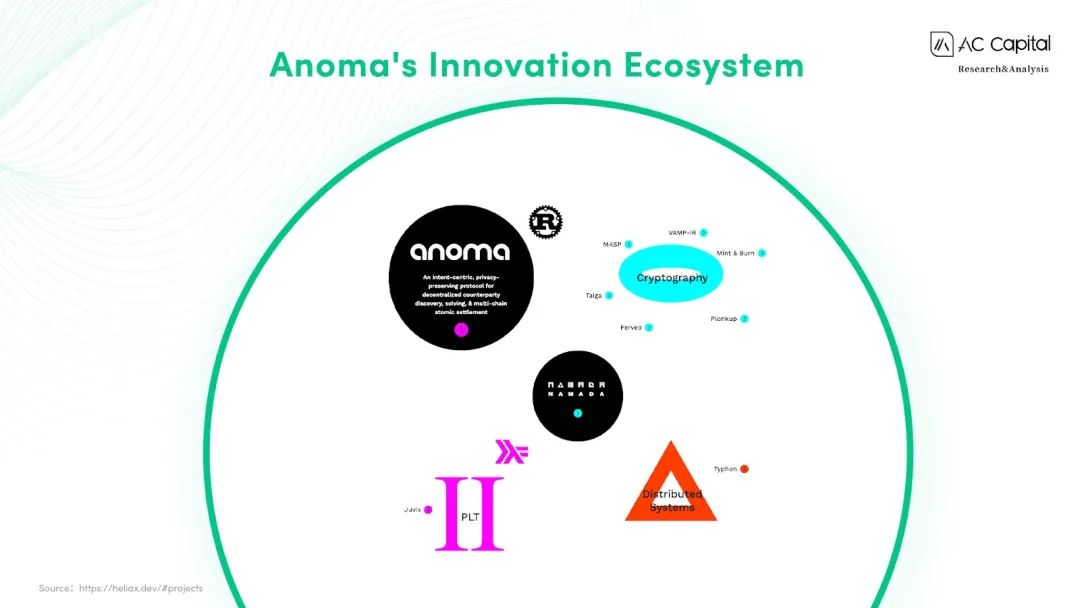
Source: https://heliax.dev/#projects
Although many institutions such as CMCC Global, Electric Capital, and Delphi Digital are highly praising Anoma and expressing that the intent-centric architecture has unlimited potential in the future, the current top-down Anoma has only laid a solid technical foundation but lacks exciting real-world applications. On the other hand, TG Bot opens up the imagination of landing scenarios with on-chain automated trading tools.
Unibot is a Telegram-based trading bot (TG Bot) that allows users to automate DEX trading through Telegram and provides functions such as sniper buying, copy trading, DEX limit orders, privacy, and anti-MEV. Unibot replaces the cumbersome interaction of Uniswap with Intent, providing a convenient DeFi interaction experience. Unibot has also spawned a group of TG Bot simulation platforms, and the total market value of the TG Bot track has reached nearly $200 million.
Anoma, a top-down approach, is an innovation, while TG Bot, a bottom-up approach, is a revolution; Anoma, starting from a intent-based underlying architecture, has made slow progress; although TG Bot brings users a brand-new on-chain interactive interface, it is not intelligent and has many security risks.
These two different paths have the same goal – to simplify user interaction experience and introduce a new programmable and customizable user interaction interface – User Intent Layer, allowing users to skip complex on-chain interaction and define transaction states based on user intent.

02, AI is the New UI: Command Interaction vs. Intent Interaction
The above two use cases have a basic understanding of intent, and now it’s time to explore the fundamental changes brought by AI – changes in the user interaction interface in the crypto world.
The AI paradigm is introducing the third user interface paradigm in the history of computing, shifting to a new interaction mechanism where users tell the computer what they want instead of how to do it.
- Paradigm 1: Batch processing.
- Paradigm 2: Command-based interaction design.
- Paradigm 3: Result specification based on intent.
Every revolution in interaction patterns in history has resulted in new business models. The generative AI based on LLM has brought disruptive changes to human-computer interaction, directly transforming the previous human-computer interaction with various software UIs into interaction with Chatgpt chat windows. This is an unprecedented interactive experience. LLM+crypto brings a new proposition of intent-based interaction to the crypto world. LLM will also make blockchain interaction potentially smarter by discovering and describing user intent.

03, Concept evolution, interaction paradigms, current status, and trends of Intent
After gaining a deep understanding of the AI intelligence trend behind intent, we further explore the concept evolution of intent. Intent is not a new concept; it has existed since the Web 2.0 era. With the rise of search engines like Google, users can input their intent, and the search engine provides relevant search results to meet that intent.
With the rise of e-commerce platforms like Amazon and eBay, there has been a significant shift in intent-based architecture. Users can now express their intent to purchase products, and the platform takes care of logistics. In early 2017, Gartner published a report titled “Innovation Insight: Intent-Based Networking Systems,” formally introducing the concept of Intent-Based Networking. The key to intent-based networking is to present users with an interface where they only need to express what they want, and the platform handles the business details.
Intent-based networking is the development trend of Web 2.0 era network automation and intelligence. Andrew Lerner, Vice President of Gartner Research, pointed out in 2017 that intent-based networking would be the next milestone in the field of networking.
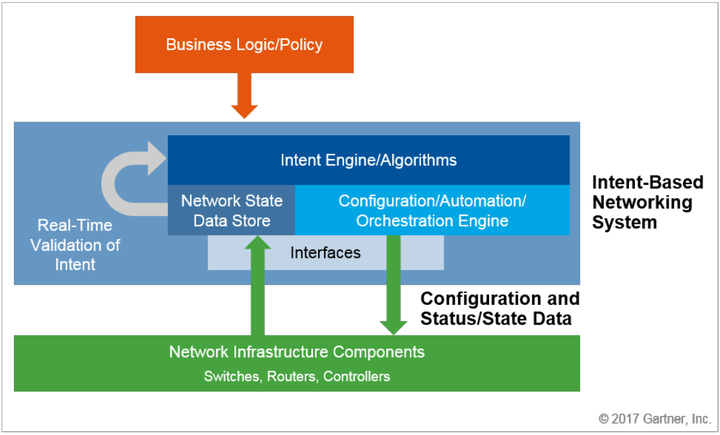
Source: https://www.gartner.com/en/documents/3599617
Evolution from Web2 to Web3, the concept of intent in Web3 is not clear, but there are some consensuses:
- Definition by LianGuairadigm: Intent is a set of declarative constraints that allow users to delegate transaction creation to specialized third-party participant networks while retaining full control over the process.
- Definition by Anoma, the underlying Dapp architecture based on intent: Intent is a message sent by the user to express custom preferences. Intent is a constraint that defines what the user-defined system can do, rather than the specific execution path.
- Definition by Propellerheads, the intent-based transaction infrastructure: Intent is the part of a transaction that requires help from others. Intent simplifies complex transactions by outsourcing the difficult parts to third parties.
In real use cases of Web3 transactions based on intent, users create intents off-chain and outsource them to Solvers (resolvers) off-chain. Solvers encapsulate the complexity of blockchain interaction and users retain full control over the process on-chain, reducing the threshold for on-chain interaction.
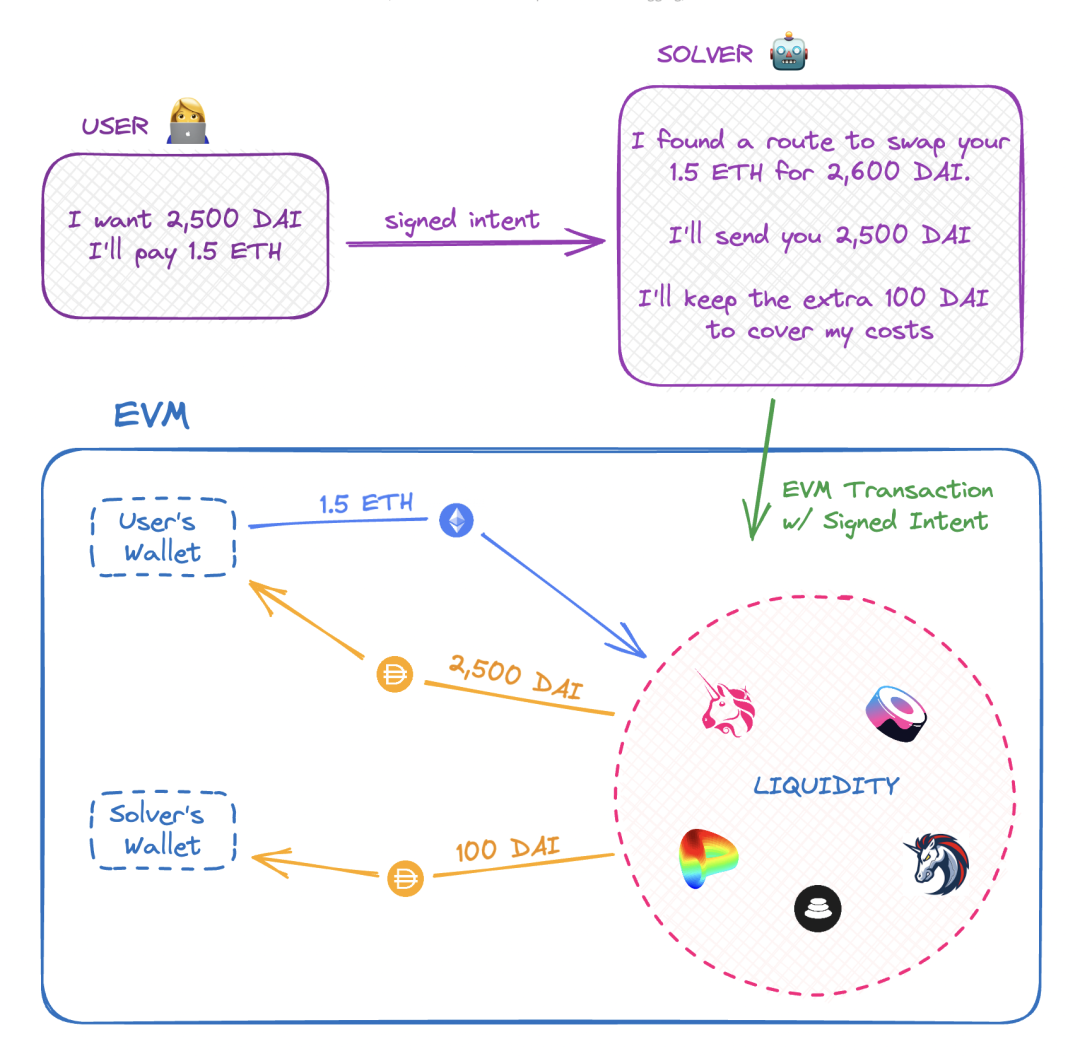
Source: https://www.brink.trade/blog/powerful-intents-LianGuairt-1
Intent also brings the concept of LLM architecture – intent-centric – an architecture centered around user intent. Currently, encryption protocols and infrastructure related to intent-centric are embedded in the interaction layer between users and Crypto, leveraging LLM to provide a better on-chain interaction experience.
LLM+Crypto brings a new paradigm of human-computer interaction, allowing user intents to be directly converted into smart contract calls. Users only need to express their intents like using Apple’s Siri, and robots/AI agents/third-party resolvers help complete complex on-chain operations. In the future, intent-based Web3 interaction intelligence has the potential to significantly reduce the complexity of user on-chain interactions.
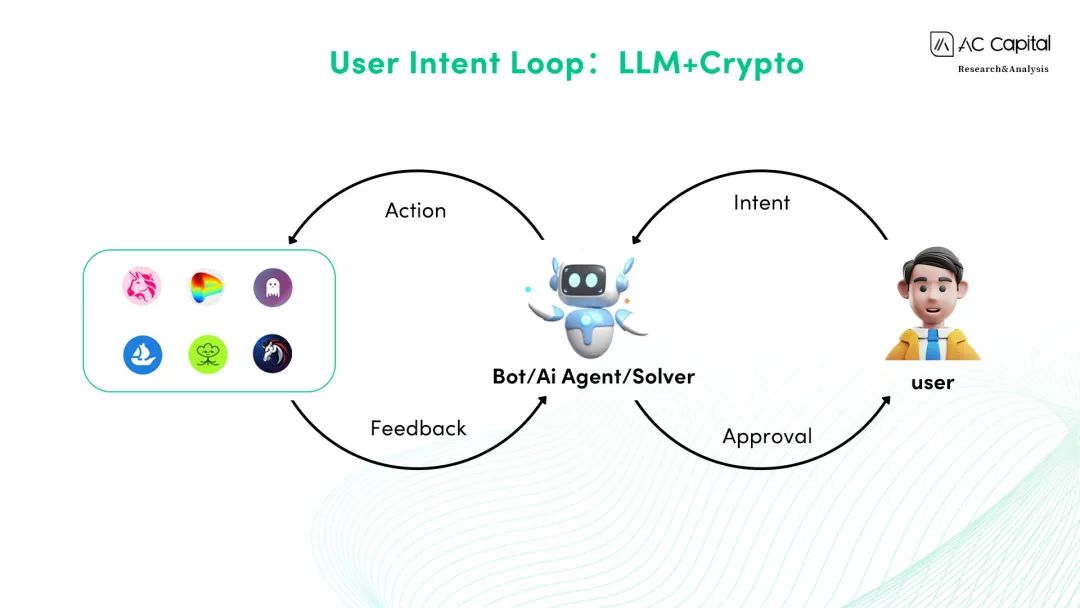
AI is the New UI, more and more Web3 projects are exploring the magic of intent. Whether it’s intent-based Dapps or intent-based underlying architectures, they unleash the potential of intent from different perspectives. We are trying to organize this rapidly developing field and divide it into four categories from the perspective of interaction, and track the latest developments and trends:

Infrastructure: (Intent-centric intent architecture layer)
- DappOS: The first intent-centric Web3 operational protocol that builds an intermediate layer between users and encryption infrastructure such as public chains and cross-chain bridges, allowing Web3 users to seamlessly interact with products without any perception. Recently, DappOS released version 2;
- Flash 2.0 SUAVE: SUAVE is an independent plug-and-play modular MEV full-chain ordering layer. Preferences (the core concept of SUAVE) are similar to the concept of intent, both providing a way for ordinary users to customize transactions and ultimately helping users achieve optimal execution. Flashbots plans to launch SUAVE Centauri in Q4 2023;
- Anoma: An intent-centric general-purpose Dapp architecture that can be modularly deployed to L1, L1.5, and L2, and can be called within various EVM frameworks through modular components. The latest development in the Anoma ecosystem is that Anoma’s privacy settlement Layer1 – Namada is about to be released on the testnet v0.22.0;
- Cow Protocol: CoW Protocol builds a underlying settlement network for traders and resolvers and released a brand new intent system called Cow Hooks in July to enable custom DeFi operations. In August, CoW Protocol processed a total transaction volume of 1.05 billion and generated a profit of 5.3 million.
Supporting facilities: (Supporting infrastructure related to intent and account abstraction wallet)
- ERC 4337: ERC 4337’s User Operation is the user’s intent, including tokens for paying gas, payment options, login methods, replacing the current transaction memory pool, thereby achieving account abstraction and improving wallet interaction experience.
- Supporting facilities related to account abstraction: Bundler infrastructure (StackUp, Blocknative, Alchemy Rundler, AA-Bundler, infinitism Bundler), wallet SDK (Safe, ZeroDev, Biconomy);
- Supporting facilities related to intent: Juvix (intent-based programming language), Seaport (open-source NFT trading protocol), Gelato (Web3 automation layer providing automated services for smart contracts), okcontract (low-level intent automation tool), Delegatable (smart contract authorization proxy tool), Hyper Oracle (off-chain automation service), symmio (intent-based on-chain derivative trading framework).
Enterprise applications: (Integrated intent infrastructure for Dapps, API, modular intent layer, domain-specific parsers)
- Transaction parser API: PropelleHeads;
- Intent API: EnsoFinance;
- Intent transaction infrastructure: Bob the Solver, Brink;
- Composable intent tools: Essential.
Consumer applications: (Smart interfaces for user interaction such as wallets, Dex, Web3 AI agents, smart search engines)
- Wallets: Safe, Bitconomy, Argent, Ambire, Sequence, Versa, A3SProtocol;
- Dex: CowSwap, LianGuairaswap, Uniswap, 1inch, BananaHq, basedmarkets;
- Smart front-ends: Unibot, Dora, Web3 Analytics, kaito.ai.
Based on intent architecture, supporting facilities, and enterprise applications (due to space limitations, only listed without elaboration), the underlying challenges of implementing intent-based solutions are attempted to be addressed. However, infrastructure development cannot be achieved overnight. The trend of consumer applications at the intent layer is what truly excites people, as wallet and Dex interaction entry points demonstrate the potential for intelligent interaction.
Intelligent Wallets: ERC-4337 introduces a new UserOps (User Operations) intent layer, where users express their intent, and then the Bundler converts these intents into executable signed transactions. In recent months, the number of ERC4337 users has increased significantly, and ZeroDev, Biconomy, and Safe modular intelligent accounts are the most motivated to promote AA + intent. AA + intent has the potential to drive the arrival of Smart Contract Wallets (SCW).

Source: https://dune.com/niftytable/account-abstraction
DEX Architecture Transformation: Intent-based trading aims to improve capital efficiency and user interaction experience. CoW Hooks connects complex actions such as trading, bridging, staking, and depositing. UniswapX already allows users to sign intents for off-chain matching and on-chain settlement. Similar to BananaHq, Brink, basedmarkets, and other intent-based DEX platforms are gradually increasing. The new Intent-based RFQ narrative (SYMMIO) is unfolding. With more and more DEXs and aggregators transitioning to intent-based architecture, the DEX landscape is undergoing tremendous changes.
Source: https://twitter.com/BananaHQio/status/1694013407929020740
Intelligentization of interactive entry: Similar to the transformation of TG Bot for the Web3 frontend interactive interface, the interactive entry focuses on understanding the user’s intentions and systematically converts them into automated and actionable tasks. It is not only TG Bot-like trading robots, but also Web3 AI Agents and Web3 intelligent search engines that are making Web3 interactions more intelligent.
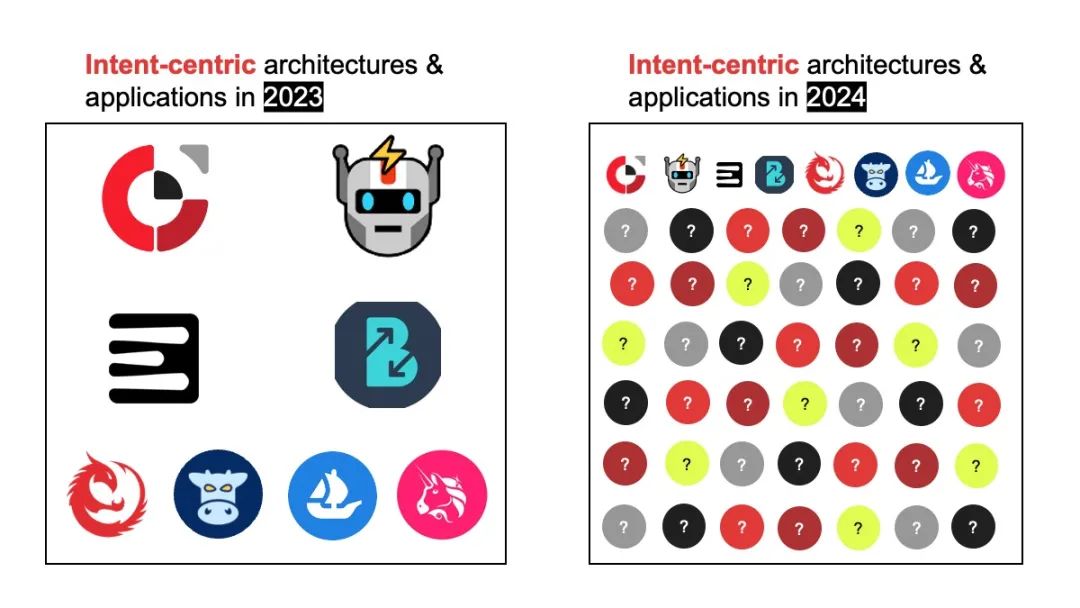
Source: https://twitter.com/awasunyin/status/169540582237605496
04. Challenges and Prospects of Intelligentization in Web3 Interactions
In the past, the user experience of Web3 products has indeed hindered widespread adoption, as the on-chain wealth creation effect has overshadowed many product issues. Now liquidity and user attention are both fragmented, and on-chain liquidity is scarce.
At the ETHCC conference in July, developers extensively discussed the future of intent-centricity and how to help users complete DAPP interactions more intelligently in Web3. However, intent-centricity still faces many challenges in its application:
- Lack of intent-related programming languages (similar to Juvix)
- Lack of suitable intent architecture (similar to Anoma)
- Lack of domain-specific solvers (similar to Bob The Solver)
- Centralized and closed intent implementation (similar to CowSwap)
- Lack of frontend intent recognition parsers (similar to Unibot)
- Lack of composable intent implementation (similar to Brink)
- Intent security risks (mentioned in the LianGuairadigm article)
There are challenges, but there is also hope. With the emergence of intent-centric protocols, Web3 has the potential to evolve into a more user-friendly intelligent interaction interface, allowing users to interact with mainstream applications such as Uniswap, Blur, AAVE, etc. in a one-stop manner. Interaction will be as simple as taking an Uber, presenting a real opportunity for Web3 Dapps to surpass Web2 in terms of user experience.
More importantly, combining Anoma, Flashbots SUAVE, and DappOS, and envisioning the future of intent-centricity, Web3 on-chain interactions will become more intelligent, customizable, and fair. At the same time, by placing the focus on intent, the power of discourse is returned to the hands of users, allowing ordinary users to empower third-party robots/parsers to complete customized transactions (fees, slippage, privacy, cross-chain, MEV, or other intentions). In the future, users will no longer be passive participants on the chain or victims of MEV searchers and validators, but the true helm of on-chain activities.
Looking forward to the future of intelligentization in Web3 interactions, whether it is account abstraction, chain abstraction, or intent, Web3 is finally caring about user experience, and the dawn of intelligent interaction is about to illuminate the dark forest.
Acknowledgements
Special thanks to Web3 Analytics, Crypto V, Haotian, Jason Chen, Luke, Grace Deng, SixSix.eth, POOR DAO, #017, armonio.eth, and Kiwibig.eth for their valuable discussions, opinions, and feedback on this article.
Reference
最近很多文章分析,确实没看明白叙事的核心是什么。如果是在聊一个现象,那确实币圈历来的趋势都是极致地把操作全部抽象和自动化,从聚合器、CEX、合约钱包、跨链defi其实都在做这些工作,还有chainlink和最近的自动化中间件,还有最近telegram bot。似乎不需要IC来描述这一现象。
— Mindao (@mindaoyang) August 30, 2023
WTF are Intents?
If you’re wondering what the newest buzzword “intents” are, look no further.
There's no better way to understand intents than by starting with @anoma, an intent-centric architecture that has been in stealth development for years ⬇️🧵 pic.twitter.com/GBSJ27RqQT
— Delphi Digital (@Delphi_Digital) August 29, 2023
https://twitter.com/awasunyin/status/169540582237605496
Intents that get settled on chain are everywhere already. If you've ever traded on @1inch, @0xProject, @CoWSwap, @opensea, @blur_io, or used an app powered by @gelatonetwork your signed messages are being processed by off chain solvers and settled on chain pic.twitter.com/OBFcxRuTXw
— ren (wassie arc) (@0xren_cf) June 1, 2023
12/ RFQ/limit orders are specific types of intents orders that are typically sent to a gated pool of market makers and solvers selected by the dapp to prevent value leakage.
The graph shared by @sui414 provides an excellent summary of the current order flow lifecycle. https://t.co/Ec9Zg2RwBv pic.twitter.com/1qn51bIl2K
— 𝔏𝔲𝔨𝔢🥝 (@LukeWasm) August 15, 2023
8⃣@_sailexchange is an intent-based orderbook dex on @fuel_network with no further information.
21/
— Dr.DODO (@DodoResearch) August 24, 2023
https://www.coindesk.com/business/2023/05/31/crypto-infrastructure-firm-anoma-foundation-raises-25m/
https://dune.com/tk-research/telegram-bots
https://ethglobal.com/showcase/bob-the-solver-yxtgp
https://medium.com/banana-sdk/intent-is-all-you-need-LianGuairt-1-1c5c11ee3b6f
https://medium.com/alliancedao/intents-are-just-7deaeb4336be
https://medium.com/@okcontract/introducing-low-level-intents-a-summary-of-our-talk-at-ethcc-6-5f8246c8063
https://bwetzel.medium.com/intent-based-architectures-and-projects-experimenting-with-them-c3ee63ae24c
https://mirror.xyz/sevenxventures.eth/fknoBf3zOoBf55zNFBpMQAIat6iCT9tvrN2AY1j4Sv4
https://dba.mirror.xyz/NTg5FSq1o_YiL_KJrKBOsOkyeiNUPobvZUrLBGceagg
https://www.propellerheads.xyz/blog/intents-and-where-to-find-them
https://www.propellerheads.xyz/blog/blockchain-and-llms
https://www.paradigm.xyz/2023/06/intents
https://review.stanfordblockchain.xyz/p/24-intents-principles-and-practice?utm_source=profile&utm_medium=reader2
https://www.nngroup.com/articles/ai-LianGuairadigm/
https://aigc.phodal.com/llm-arch-user-intent-oriented-design.html
https://gracedeng.substack.com/p/decoding-intents-revolutionizing
https://web3datadegens.substack.com/p/the-future-of-transactions-for-dummies?utm_camLianGuaiign=post&utm_medium=web
https://thedefisaint.substack.com/p/intent-centric-a-narrative-worth
https://writings.fetcch.xyz/how-to-think-about-cross-chain-cowswap
https://www.brink.trade/blog/powerful-intents-LianGuairt-1
https://blog.essential.builders/introducing-essential/
https://www.propellerheads.xyz/blog/intents-and-where-to-find-them
https://writings.flashbots.net/the-future-of-mev-is-suave/
https://www.blocknative.com/blog/ethcc-understanding-4337
https://writings.flashbots.net/mevm-suave-centauri-and-beyond
https://ethresear.ch/t/how-can-we-decentralize-intents/16456
https://www.gartner.com/en/documents/3599617
We will continue to update Blocking; if you have any questions or suggestions, please contact us!
Was this article helpful?
93 out of 132 found this helpful
Related articles
- FTX may be approved to liquidate $3.4 billion worth of tokens this week. What impact will it have on the market?
- August DeFi Market Review and Outlook Which Protocols and Airdrops to Focus on?
- Against the Wind How to Use Web3 to Ignite the Market and Drive Growth?
- Detailed Explanation of New Changes in US Cryptocurrency Accounting Rules What Impact Does It Have on MicroStrategy, Coinbase, and Others
- Nigeria Second Largest Bitcoin Adopting Country, the Cradle of Cryptocurrency Growth
- Overseas Web3 Employment Report Remote Work in High Demand, US as the Main Job Market
- Wu’s Weekly Selection Tether becomes the 22nd largest holder of US Treasury bonds globally, Grab adds Web3 wallet and News Top10 (0902-0908).





